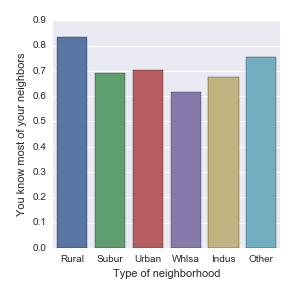Communities Data visualizations
by ptdriscoll
Comments Off on Rural teens know their neighbors more than teens in cities
Rural teens know their neighbors more than teens in cities
Where teens live makes a difference in how well they know their neighbors, shows an analysis of data from the National Longitudinal Study of Adolescent Health.
The data comes from a school-based survey of 6,504 youth in grades 7-12 in the U.S.
Nearly 4,700 adolescents living in either rural, suburban, urban or several other types of neighborhoods responded to: “You know most of the people in your neighborhood.”
Results show 83 percent of rural teens said yes, while 69 percent of suburban teens and 70 percent of urban teens said they do.
Social capital in urban, suburban and rural settings
Research shows adults and communities benefit from social connections. Less is known about teenagers, and whether neighborhood features foster such social capital.
Studies tell us that where teens live can make a difference in their educational success, risky behaviors and social interactions. Also, youth spend a lot of time outside at a formative time in their development.
So, do urban, suburban and rural settings play a role in building social capital?
In a national survey of 6,504 adolescents, respondents were asked if they knew most of their neighbors. Turns out, suburban teens were most likely to say they did not.

However, not all social familiarity is the same. Gangs too have high social capital.